Fiat currency in the context of crypto refers to government-issued money, like the U.S. Dollar or Euro, recognized as legal tender. Its value is based on trust in the issuing authorities rather than any intrinsic worth. While fiat provides stability and is widely accepted for transactions, cryptocurrencies operate on decentralized networks, challenging traditional finance. They often carry lower fees and faster transaction times but come with risks, such as volatility and regulatory uncertainty. If you're curious about how these currencies interact and what that means for you, there's much more to uncover.
Key Takeaways
- Fiat currency is government-issued money, recognized as legal tender, and operates under the trust in the issuing government.
- In the context of crypto, fiat currencies can be used to purchase cryptocurrencies on exchanges.
- Unlike cryptocurrencies, fiat currencies are centralized and regulated by central banks.
- The value of fiat currency can be affected by inflation, impacting its purchasing power over time.
- CBDCs are digital versions of fiat currencies that aim to combine benefits of both fiat and cryptocurrencies.
Fundamental Principles of Currency
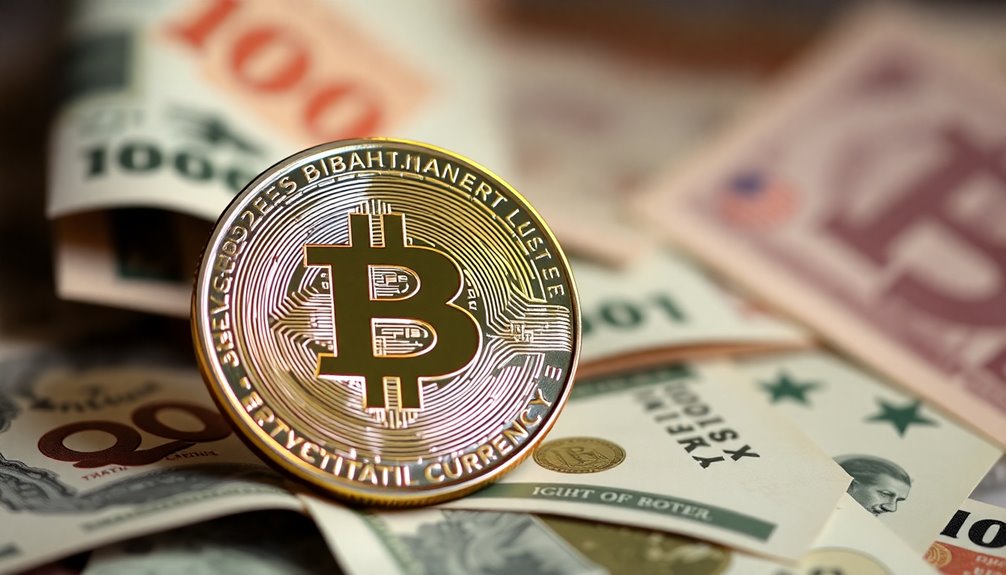
When you think about currency, it's essential to understand its fundamental principles, especially the distinction between fiat and cryptocurrencies.
Fiat currency, like the U.S. dollar or Euro, is government-issued money and serves as legal tender for all debts. Its value hinges on trust in the issuing government rather than intrinsic worth. Central banks regulate fiat, managing the money supply and monetary policy to ensure economic stability.
In contrast, cryptocurrencies operate on decentralized networks and rely on blockchain technology. The value of fiat is influenced by inflation and interest rates, while cryptocurrencies often face higher volatility.
As the world moves towards digital currencies, Central Bank Digital Currencies (CBDCs) aim to blend the strengths of fiat with the technological benefits of cryptocurrencies.
Historical Context of Currency

Understanding the historical context of currency reveals how fiat money evolved to meet the needs of society. In the 11th century, China's government introduced paper money, making trade easier by replacing cumbersome coins and physical assets.
The transition accelerated in the 20th century, especially after the U.S. abandoned the gold standard in 1971, creating a system where fiat currency isn't backed by tangible resources. Today, currencies like the U.S. Dollar and Euro dominate, with central banks managing their supply to ensure stability.
However, fiat money has faced challenges like inflation and rapid devaluation, as observed in Zimbabwe. The rise of cryptocurrency in the 21st century marks a shift, emphasizing decentralization and market-driven value, independent of government control.
Transaction Verification Process
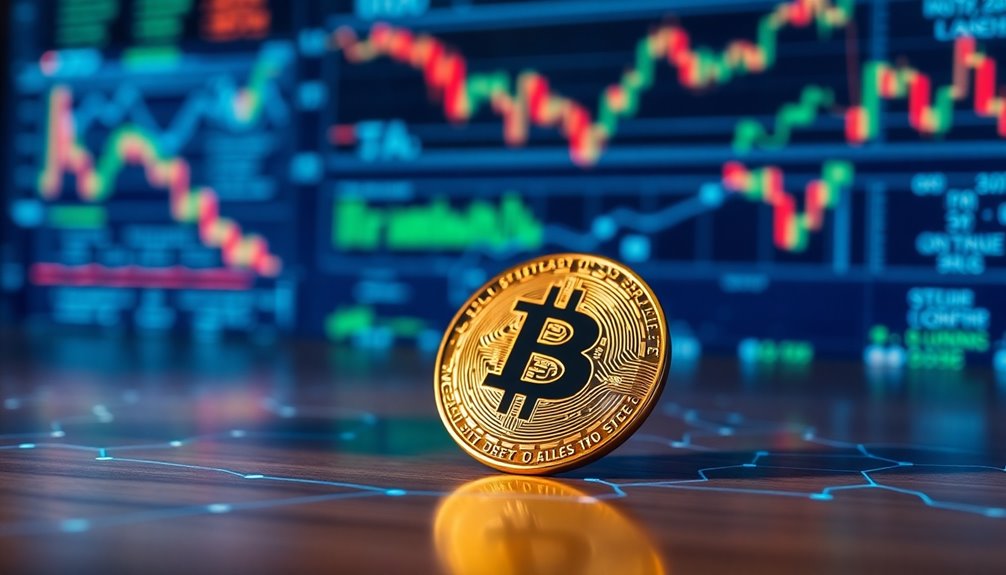
In the world of cryptocurrency, transaction verification is crucial for maintaining the integrity of the network. Using mechanisms like Proof of Work or Proof of Stake, the verification process ensures that all digital transactions are legitimate and securely recorded on the blockchain.
In Proof of Work, miners compete to solve complex problems, adding blocks of transactions and earning rewards. Alternatively, Proof of Stake allows validators to create new blocks based on their cryptocurrency holdings, which lowers energy consumption.
Once verified, transactions become immutable, meaning they can't be altered or reversed. This speeds up the process, enabling near-instantaneous transactions without a central authority, making cryptocurrency a more efficient alternative to traditional fiat currency systems.
Pros and Cons
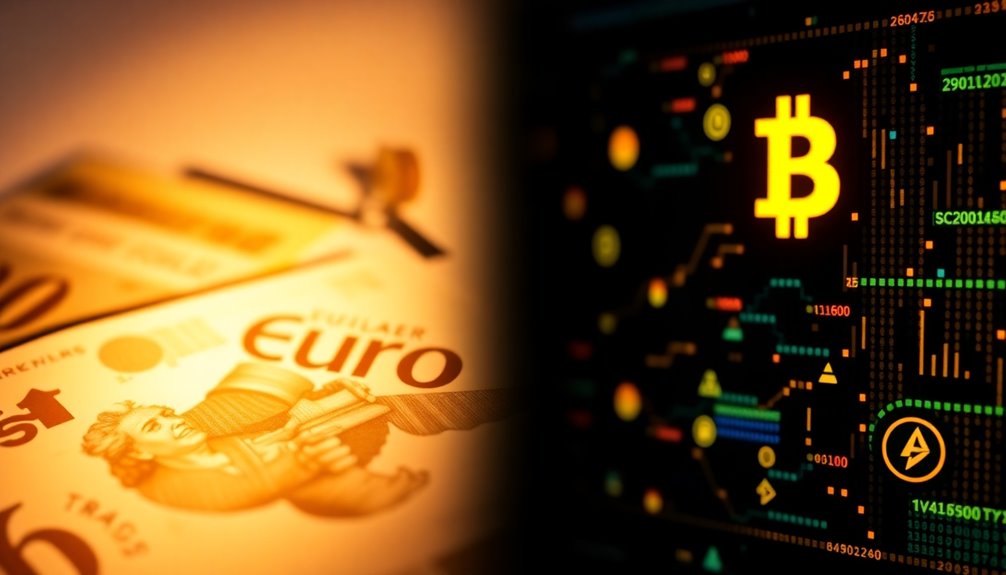
While both fiat currency and cryptocurrency have their advantages and disadvantages, it's essential to weigh them carefully to determine which suits your needs better.
Fiat currencies offer stability and widespread acceptance, making them reliable money for everyday transactions. However, they can suffer from inflation, decreasing your purchasing power over time.
On the flip side, cryptocurrencies often provide lower fees and faster cryptocurrency transactions, eliminating intermediaries. Yet, they can be less accepted in traditional markets and face a constantly evolving regulatory environment.
This uncertainty can pose risks for users, while fiat's established regulations provide a sense of security.
Ultimately, your choice depends on your priorities regarding stability, acceptance, and protection against inflation.
Fiat vs. Crypto Volatility
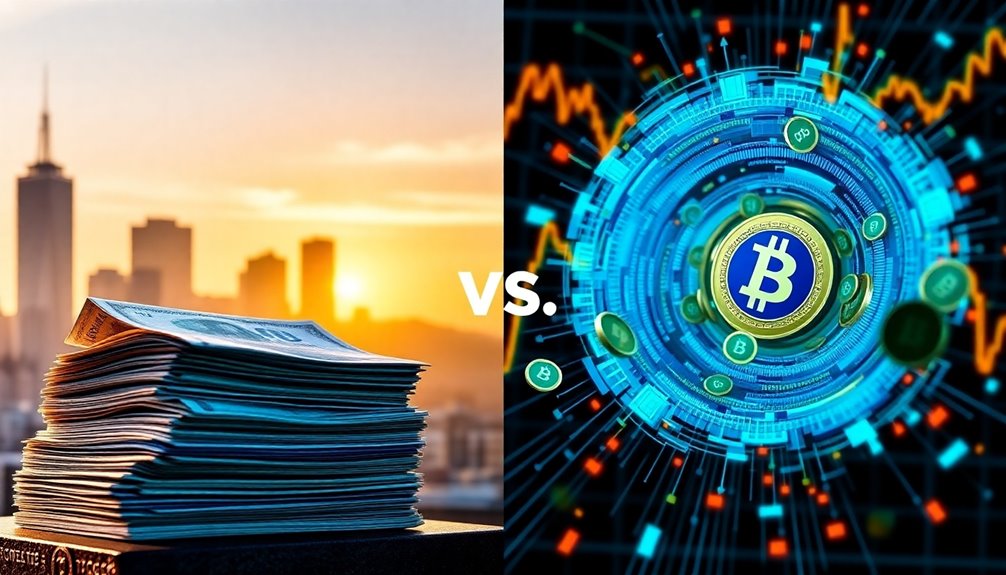
When comparing fiat currencies to cryptocurrencies, you'll quickly notice that fiat tends to offer more stability, making it a safer choice for everyday transactions.
The value of fiat money fluctuates minimally, with inflation rates averaging 2-3% annually. In contrast, cryptocurrencies, like Bitcoin, can experience price volatility exceeding 30% in a single month. This unpredictability stems from supply and demand dynamics and market speculation.
Stablecoins aim to bridge this gap by pegging their value to fiat currencies, providing a more stable alternative. However, both fiat and cryptocurrencies are influenced by central authorities and macroeconomic factors such as interest rates.
Ultimately, while fiat currencies support a stable financial system, cryptocurrencies present a high-risk, high-reward environment for investors.
Market Manipulation Concerns

Market manipulation is a significant concern in the cryptocurrency space, as deceptive practices can severely impact your investments. Tactics like "pump and dump" schemes artificially inflate a coin's value, leaving unsuspecting investors stuck with devalued assets.
In many cryptocurrency exchanges, the lack of regulation allows for manipulative behaviors, such as wash trading, which creates misleading volume statistics and a false sense of demand. Research shows over 90% of trading volume on some exchanges may be fake, highlighting the prevalence of market manipulation.
Regulatory bodies, like the SEC, are investigating these deceptive practices, seeking to improve transparency and protect investors in crypto markets. Enhanced oversight is essential to mitigate these risks and foster a healthier trading environment.
Emergence of Central Bank Digital Currencies

As the digital economy evolves, Central Bank Digital Currencies (CBDCs) are emerging as a significant innovation in the financial landscape.
These digital currencies, issued by central banks, aim to provide a stable alternative to traditional fiat currency. Over 100 countries are exploring or piloting CBDCs, with China leading through its digital yuan.
CBDCs enhance financial inclusion and streamline payment systems, improving monetary policy efficiency. Unlike cryptocurrencies, CBDCs are centralized, maintaining the trust associated with fiat currencies, while offering the advantages of digital transactions.
The development of CBDCs is set to reshape the financial landscape, reducing reliance on private cryptocurrencies and bolstering transaction security and transparency.
This evolution marks a critical step toward a more efficient and inclusive financial system.
Diversify Your Investment Portfolio
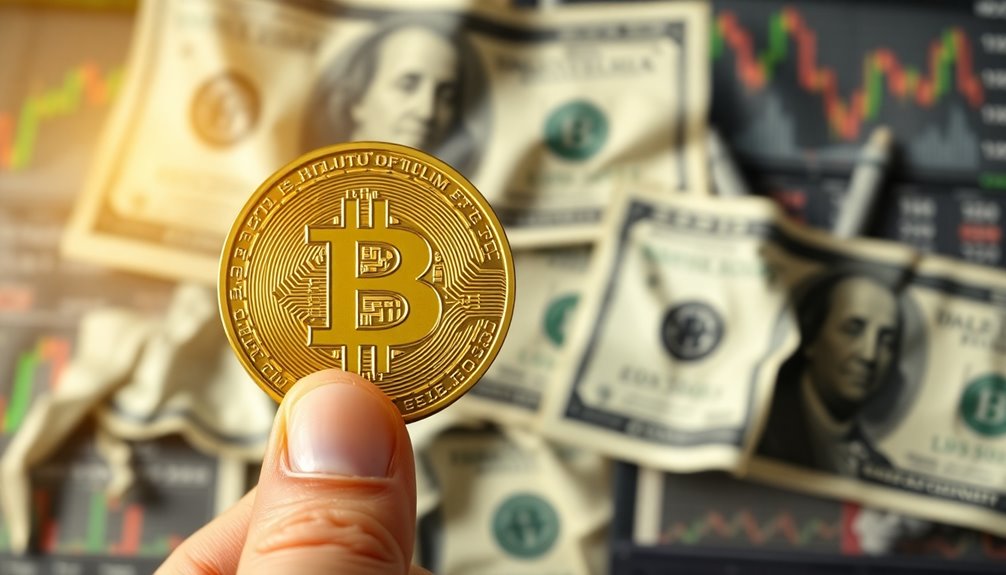
With the rise of Central Bank Digital Currencies (CBDCs) reshaping the financial landscape, it's more important than ever to think about how to diversify your investment portfolio.
Incorporating various asset classes, including fiat currencies, stocks, bonds, and cryptocurrencies, can significantly reduce risk. As 2024 approaches, anticipate that 20% of large enterprises will adopt digital currencies, highlighting the need to include these digital assets in your strategy.
Stablecoins, pegged to fiat currencies like the USD, help mitigate the volatility associated with traditional cryptocurrencies.
Stay updated on regulatory developments affecting both fiat and crypto markets, as these changes can influence your diversified portfolio. A well-rounded investment strategy ensures you balance potential high returns with the stability of fiat currency investments.
Frequently Asked Questions
What Is Fiat for Crypto?
Fiat for crypto refers to using government-issued currency, like the US Dollar or Euro, to buy cryptocurrencies.
You can easily convert your fiat at exchanges, where you deposit money and purchase digital assets. This process bridges traditional finance and the crypto world, making it simpler for you to enter the market.
What Is an Example of a Fiat Currency?
Imagine a world where money flows like a river, shaping economies and lives.
An example of a fiat currency is the U.S. Dollar (USD), the backbone of international trade and transactions. You might also encounter the Euro (EUR), widely used across Europe.
These currencies, unlike cryptocurrencies, are backed by governments and central banks, ensuring their value and stability.
They're accepted for debts, making them essential in everyday commerce.
Is Bitcoin a Fiat Money Too?
No, Bitcoin isn't considered fiat money.
Unlike fiat currencies, which are issued and regulated by a government, Bitcoin operates on a decentralized network. Its value comes from market demand and a capped supply of 21 million coins, not government backing.
You can't print more Bitcoin at will, as its supply is controlled through a halving process.
Plus, Bitcoin transactions are irreversible and don't require intermediaries like banks, making it fundamentally different.
Is USD a Fiat Currency?
You might think money needs to be backed by something tangible, like gold.
But the U.S. Dollar (USD) is a fiat currency, meaning it's not tied to any physical commodity. Instead, its value comes from the trust people place in the U.S. government and its economic stability.
Since the 1930s, the USD has been managed by the Federal Reserve, allowing flexibility in monetary policy, but it requires careful management to avoid inflation.
Conclusion
In the vast ocean of finance, fiat currency acts like a sturdy ship, navigating through the waves of stability, while crypto is the unpredictable wind, offering both speed and risk. As you chart your course, remember to balance your sails—embracing the strengths of both can guide you safely to your destination. By diversifying your investment portfolio, you'll harness the power of the tides, ensuring you're prepared for whatever storms may come your way.









